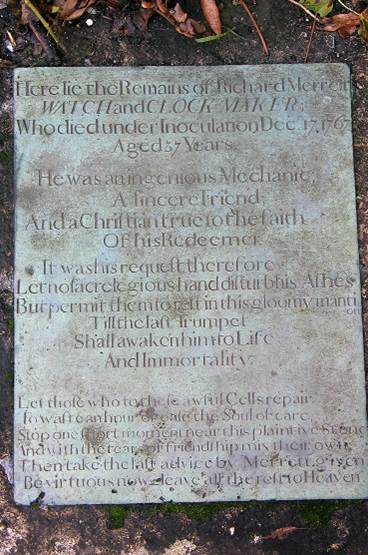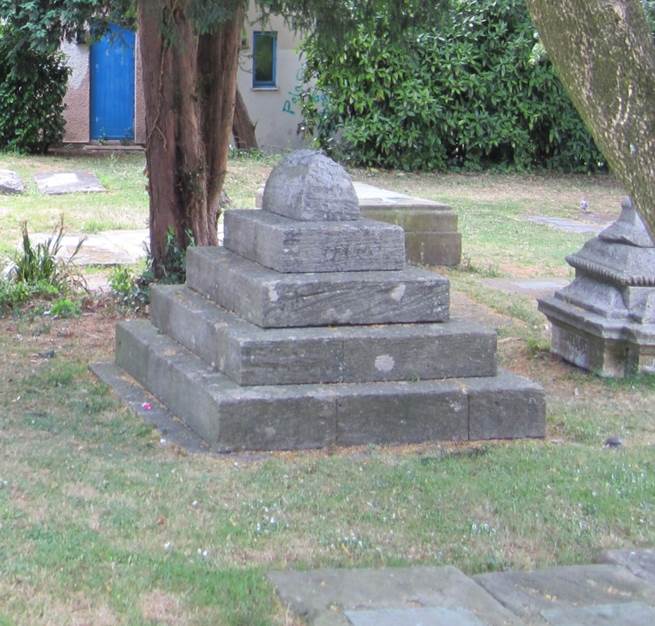A brief look at some of the people in the history of St Laurence
- The Dick Whittington Connection
- The Delmont Duel
- Notable Burials
The Dick Whittington Connection
As successive famine, plague and wars ravaged England during the medieval period, there are no surviving records relating to the church during most of the 1300s. Then in 1395, Richard ‘Dick’ Whittington, the celebrated Mayor of London, came into possession of Over (Upper) Lypiatt Manor (today Lypiatt Park). On Richard’s death it passed to his brother Robert, and was to remain in the hands of the Whittington family through to the end of the 15th century. During that time they endowed the church with much property and funds, and in about 1450 helped pay for the addition of a south aisle and porch. These lay almost exactly where today’s south aisle and porch are (the Victorian’s used the same foundations when they rebuilt the church), and the church still has in its possession the original Whittington family stone with its coat of arms which originally adorned the porch. Richard’s grandnephew Thomas is believed to have been buried under the south aisle upon his death in the 1490s. It was during this time that the Wars of the Roses (1455-1485) were fought between the Houses of York and Lancaster for the throne of England.

Paul Hawkins Fisher wrote in his “Notes and Recollections of Stroud” of 1871 that: “… the arms of the Gloucestershire family of the Whittingtons are stated, generally, to be only a fesse of two lines checky; though sometimes they bear three or four such lines, having an annulet in the right corner of the shield. The arms on the porch, however, had a fesse with two lines checky, between two crescents, without the annulet; but the repetition, in base, of the crescent in chief, as a mark of cadency, is supposed to be an error of the sculptor.” The existing stone precisely matches Fisher’s description, with a checked band of two lines running across the centre of the shield (‘a fesse of two lines checky’, in heraldic terms), lying between two crescents. The ‘mark of cadency’ that Fisher refers to is a device in heraldry used to distinguish between different male members of a particular family. The crescent is usually designated for the second son born. The mark of cadency would normally be added solely ‘in chief’, i.e. at the top of the shield. Richard ‘Dick’ Whittington, the celebrated mayor of London, came into possession of Over (Upper) Lypiatt Manor in 1395, as settlement for a debt owed to him by his uncle Philip Maunsell. On Richard’s death, without heir, in 1424 it passed to his brother Robert Whittington, and subsequently to Robert’s son Guy, and then Guy’s son Thomas, before coming into the possession of the Wye family. Robert Whittington was the second son of Sir William Whittington, which may explain the crescent mark of cadency on the arms on the stone. The stone was at some time built into the wall of the old boiler house under the vestry (which was probably the entry to the family vault), and was for many years covered by an electricity switchboard before being rescued.

The Delmont Duel 1807: The last fatal duel in England?
Probably the best known grave in the church grounds is that of Lieutenant Joseph Francis Delmont of the 82nd Regiment, who died on the 18th August 1807 of wounds received in a duel, which took place in the grounds of The Grange in Folly Lane. Delmont had made a remark to Lieutenant Benjamin Heazle that caused offence, and which he refused to apologise for. It was decided to settle the matter by a duel. Finding a couple of pistols in Stroud at short notice proved difficult, and Delmont ended up with a rusty one. Delmont was still preparing to shoot when Heazle fired his pistol, seriously wounding Delmont. The drama was compounded when the nurse tending him with a lotion for bathing his wounds, gave it to him to drink instead. He lasted a few days, being ministered to by Rev John Williams, before finally passing away. The following Sunday Williams preached a sermon at the church on “the pernicious vice of duelling”, which was later published. Delmont’s grave is in the far southwest corner of the church grounds. Click below to read the full story and to read the sermon.
Notable Burials
Thomas Stephens
The most striking monument in the church today is that of Thomas Stephens of Lypiatt, now in the east wall of the south transept, and dating to 1613. The son of Edward Stephens of Eastington, Thomas was a Middle Temple lawyer, who obtained a court appointment under King James I (whose ‘King James Bible’ was published in 1611). He was Attorney General to both Henry and Charles Stuart; Charles later becoming King Charles I.
'Under Inoculation' - Richard Merrett
In the church grounds is a plaque to Richard Merrett, a local watch and clock maker, who died in 1767 “under inoculation”. Merrett's death occurred before GP Edward Jenner, of nearby Berkeley, embarked on a series of experiments in the 1790s to find a cure for smallpox. It is possible that the inoculation referred to in this inscription was "variolation“, which was another, and often successful, means of combating smallpox. It was a procedure introduced into England in 1721 from the East by Lady Mary Wortley Montagu, wife of the British Ambassador in Turkey.
Transcription:
Here lie the Remains of Richard Merrett
WATCH and CLOCK MAKER
Who died under Inoculation on Dec. 17. 1767
Aged 57 Years
He was an ingenious Mechanic,
A sincere Friend;
And a Christian true to the faith
Of his Redeemer.
It was his request therefore
Let no sacrelegious hand disturb his Ashes
But permit them to rest in this gloomy mantion
Till the last Trumpet
Shall awaken him to Life
And Immortality.
Let those who to these awful Cells repair,
To waste an hour or ease the Soul of care,
Stop one short moment near this plaintive Stone
And with the tears of friendship mix their own;
Then take the last advice by Merrett given,
Be virtuous now - leave all the rest to Heaven
John Hollings
In the south church grounds is the tomb of John Hollings, resembling a stepped pyramid. A retired mercer, banker and JP, Hollings was appointed Captain of the Loyal Volunteers in 1798, when they were formed as part of the nation’s response to the threat of invasion by Napoleon. However, Hollings was not universally popular, and is said to have had an argument with an adversary, who declared he would like to live long enough to see him “safe underground”. Hollings replied “That you never shall!” As a precaution Hollings decreed that when his time came – which it did in 1805 – his coffin should not be interred but should be left on the surface and covered with the monument that we see today.
Mrs Sarah Sweeting
A plot of land was purchased for a new burial ground on the north side of the church From Mrs Sarah Sweeting in August 1810. Sarah was subsequently buried at St Laurence on 6 January 1825, aged 83. She was baptised at St Laurence in 1741, the daughter of Michael Ballard, and had married David Sweeting at St Laurence in 1763. Her address at death was given as Ryeford, Stonehouse, and she was a widow. Probate for her Will was given 7 April 1825. Her beneficiaries were: £100 to her son Daniel Niblett Sweeting (a painter, plumber and glazier in Tetbury); £100 to John Tyler Jones, a chemist and druggist of Stroud (married to her grand-daughter Mary Sarah Sweeting); £50 to Spencer Lambert, a coffee roaster of Aldgate, London (related to Sarah through his wife, Mary Ann Ballard); “My pew or seat in the Parish Church of Stroud” to her son Charles Page Sweeting; “Five guineas each to purchase a mourning ring to wear in remembrance of me” to her friends Charles Newman, a gentleman of Stroud, and Mary Hill, a spinster of Ryeford; “My gold watch with its appendages” to her grand-daughter Sarah Bishop; The remainder of the estate to her grand-daughter and executrix Martha Beata Miles. Sarah’s son Charles Page Sweeting was a surgeon living in King Street, Stroud. He was the surgeon who attended the fatally wounded Lt Delmont in 1807. He was also a founding trustee of Stroud Subscription Rooms. On 22 December 1829, John Purcell, a cabinet maker of Stroud, was fined £5 after pleading guilty to unlawfully selling a hare to Charles Sweeting for 2s 6d. They had been informed on by Henry Rudge.
Thomas Hughes, Surgeon
Thomas Hughes was born in Dursley in 1742. He was an apothecary and surgeon who moved to Stroud High Street in 1771, and who kept detailed weather records up to the year of his death in 1813. He was buried at St Laurence. His weather diaries, which were eventually given to the Royal Meteorological Society, provide a major contribution to what is known about the climate of the late 18th century.
James Ferrabee
James Ferrabee, son of John Ferrabee (an engineer from Thrupp) and his wife Esther, was baptised at St Laurence on 13th December 1818. He established the Phoenix Iron Works foundry at Thrupp Mill, where he produced cloth-making and farm machinery, and steam engines. His works also manufactured Edwin Budding’s lawnmower – the world’s first.
Joseph Watts
Joseph Watts (1772-1855), was proprietor of the Stroud Brewery Company, and owned Stratford House, having bought it in 1819 from Samuel Wathen of Woodchester. Jospeh’s daughter Martha (1801-1846) married Edmund Gilling Hallewell, and upon Joseph’s death in 1855, her son (Joseph’s grandson), Joseph Watts Hallewell (1823-1891) inherited the house. Joseph Watts Hallewell was educated at Rugby and Jesus College, Cambridge, and was later a magistrate for the County of Gloucester. After inheriting Stratford House in 1855, he focused his interest on the extensive grounds, and changed the estate's name from Stratford House to Stratford Park - hosting the 1870 Gloucestershire Agricultural Show. He died at Stratford Park in 1891, and the Park was sold to George Holloway MP. Joseph Watts Hallewell’s first wife was Sarah Edith Berrie (1831-1856), and she is buried at St Laurence with her husband’s grandfather. Stratford House is now Stroud’s Museum in the Park.
Family historian Laurence Hallewell has kindly supplied some additional information about the family:
"Joseph Watts Hallewell was also MP for Stroud and chairman of the local Conservative Party. Emund Gilling Hallewell was the son of a clergyman at Boroughbridge, in the West Riding, and had come to Stroud around 1800, and I was brought up to believe that “Squire Hallewell” was a distant relative. The facts were otherwise, but I was in middle age before I did some research in Stroud and found out the origin of this fond family myth, which I hope you will find of interest. My own great-great grandfather, John Hallawell, a bookbinder, had also arrived in Stroud “from the North country” (probably Saddleworth, also then in the West Riding) in 1800. His son Samuel was a house decorator, frequently in financial difficulties from alcoholism. On one such occasion in 1841 his wife Mary had to take her three month old son into Stroud Workhouse. She, being a dissenter, had to have her son baptised as a condition of admission. Out of malicious black humour she gave her name as Martha Hallewell and his as Joseph, so she could claim that “Martha Hallewell and son Joseph were now living in the workhouse.”"
Paul Hawkins Fisher
Much of what is known of the early history of the town, including St Laurence Church, is thanks to Paul Hawkins Fisher (1779-1873), who wrote a full and informative history called “Notes and Recollections of Stroud”, which was first published in 1871. The Fisher family is commemorated in a memorial by the door into the tower.







